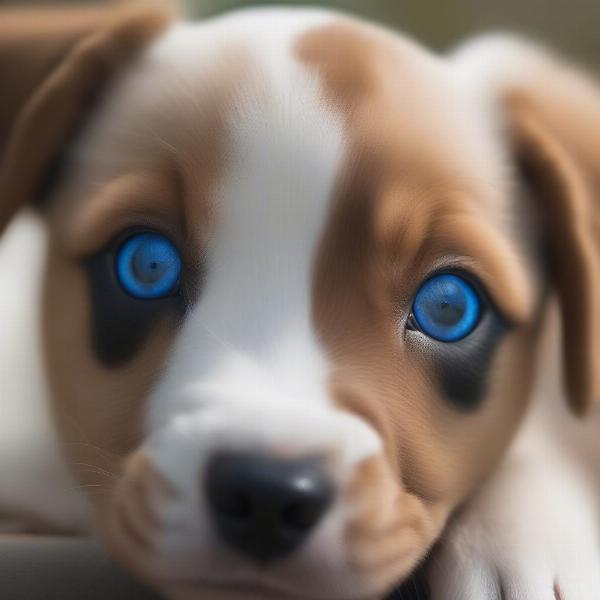Understanding changes in your dog’s eye color can be concerning. While some changes are normal, others can indicate underlying health problems. This article delves into the reasons why a dog’s eye color might change, what to look for, and when to seek veterinary attention.
Normal Eye Color Changes in Puppies
 Chó con thay đổi màu mắt
Chó con thay đổi màu mắt
Puppies are often born with blue eyes that gradually change color as they mature. This is due to the production of melanin, the pigment responsible for eye color. The final eye color typically sets in by the time a puppy is around 12 weeks old, although it can sometimes take longer, even up to several months. So, if your puppy’s eyes are changing color during their first few months of life, it’s usually nothing to worry about. This is especially true for breeds like Siberian Huskies, Australian Shepherds, and Border Collies, which are known for having heterochromia, a condition where each eye is a different color.
Causes for Concern: When Eye Color Change Isn’t Normal
While some eye color changes are a natural part of development, others can signal an issue. A sudden change in eye color in an adult dog, especially accompanied by other symptoms like redness, cloudiness, discharge, or squinting, warrants a visit to the veterinarian. These changes could indicate a variety of problems, including:
- Uveitis: Inflammation of the uvea, the middle layer of the eye.
- Glaucoma: Increased pressure within the eye, which can lead to blindness.
- Nuclear sclerosis: A normal age-related change in the lens of the eye, which can sometimes cause a slight bluish haze. While not usually harmful, it’s important to distinguish it from cataracts.
- Cataracts: Clouding of the eye lens, interfering with vision.
- Corneal dystrophy: A condition affecting the cornea, the clear outer layer of the eye. tear wipes for dogs can help maintain hygiene around the eyes.
- Injuries: Trauma to the eye can cause changes in color and appearance.
What to Do if Your Dog’s Eye Color Changes
If you notice any changes in your dog’s eye color, especially if they’re accompanied by other symptoms, it’s crucial to consult a veterinarian. Early diagnosis and treatment are essential for preventing vision loss and maintaining your dog’s eye health. Don’t attempt to self-treat eye problems, as this can worsen the condition.
Understanding Heterochromia
As mentioned earlier, heterochromia, or having two different colored eyes, is relatively common in certain dog breeds. This condition is usually harmless and doesn’t affect vision. However, acquired heterochromia, where the eye color changes later in life, can be a sign of an underlying medical condition. Therefore, it’s important to have any changes in eye color checked by your veterinarian. grey hair dogs sometimes exhibit changes in eye pigmentation as part of the aging process.
Conclusion
While some eye color changes in dogs are normal, particularly in puppies, others can indicate serious health problems. Being attentive to your dog’s eye health and seeking prompt veterinary care when needed is crucial for maintaining their vision and overall well-being. Remember, changes in eye color, especially when accompanied by other symptoms, should never be ignored. color dye for dogs should not be used near the eyes.
FAQ
- Is it normal for a puppy’s eyes to change color? Yes, it’s quite common for a puppy’s eye color to change as they mature.
- When should I be concerned about my dog’s eye color changing? If the change is sudden, occurs in an adult dog, or is accompanied by other symptoms like redness, cloudiness, or discharge, you should consult a veterinarian.
- What could cause a dog’s eye color to change suddenly? Several conditions, including uveitis, glaucoma, cataracts, and injuries, can cause sudden changes in eye color.
- Is heterochromia harmful to dogs? Inherited heterochromia is usually harmless. However, acquired heterochromia can be a sign of an underlying medical issue.
- Can I treat my dog’s eye problems myself? No, you should always consult a veterinarian for any eye problems. Self-treating can worsen the condition.
- What should I do if I notice a bluish haze in my older dog’s eyes? This could be nuclear sclerosis, a normal age-related change. However, it’s important to have it checked by a veterinarian to rule out other conditions like cataracts.
- Are certain dog breeds more prone to eye color changes? Yes, some breeds, like Siberian Huskies and Australian Shepherds, are more likely to have heterochromia. white hair dye for dogs can sometimes stain around the eyes, so care should be taken.
ILM Dog is your trusted source for expert advice on all aspects of dog care, from breed selection and puppy care to senior dog health and training. We offer comprehensive resources, including articles on nutrition, grooming, health, and behavior. Explore our website for more helpful tips and guidance on providing the best possible care for your furry companion. Contact us today at [email protected] or +44 20-3965-8624. Visit ILM Dog for more information. what tv shows do dogs like may not be directly related to eye health, but it’s an example of the diverse content we offer.